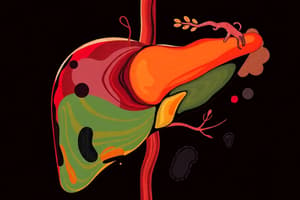Podcast
Questions and Answers
What is the approximate percentage of the pancreas that is comprised of the exocrine pancreas?
What is the approximate percentage of the pancreas that is comprised of the exocrine pancreas?
- 50-60%
- 10-20%
- 80-90% (correct)
- 20-30%
What is the function of the duct system in the pancreas?
What is the function of the duct system in the pancreas?
- Produces hormones
- Filters blood
- Regulates blood sugar levels
- Collects and transports digestive enzymes to the duodenum (correct)
Which type of islet cell produces pancreatic polypeptide?
Which type of islet cell produces pancreatic polypeptide?
- Delta cells
- Beta cells
- Alpha cells
- PP cells (correct)
What is the name of the duct that merges with the common bile duct to form the ampulla of Vater?
What is the name of the duct that merges with the common bile duct to form the ampulla of Vater?
Which of the following arteries supplies blood to the pancreas?
Which of the following arteries supplies blood to the pancreas?
What is the name of the vein that drains the pancreas alongside the superior mesenteric vein?
What is the name of the vein that drains the pancreas alongside the superior mesenteric vein?
What is the function of the beta cells in the islets of Langerhans?
What is the function of the beta cells in the islets of Langerhans?
What is the name of the papilla through which the ampulla of Vater empties into the duodenum?
What is the name of the papilla through which the ampulla of Vater empties into the duodenum?
What is the location of the pancreas in the abdominal cavity?
What is the location of the pancreas in the abdominal cavity?
Flashcards are hidden until you start studying
Study Notes
Pancreas Histology
Gross Anatomy
- The pancreas is a retroperitoneal organ located in the upper left quadrant of the abdomen
- Divided into head, neck, body, and tail regions
- Surrounded by a thin layer of connective tissue called the pancreatic capsule
Microscopic Structure
Exocrine Pancreas
- Comprises 80-90% of the pancreas
- Consists of acinar cells that produce digestive enzymes
- Acinar cells are arranged in clusters (acini) surrounded by a network of capillaries
- Each acinus has a central lumen that drains into a duct system
Endocrine Pancreas
- Comprises 10-20% of the pancreas
- Consists of islets of Langerhans that produce hormones
- Islets are scattered throughout the pancreas and surrounded by a rich network of capillaries
- Four main types of islet cells:
- Alpha cells: produce glucagon
- Beta cells: produce insulin
- Delta cells: produce somatostatin
- PP cells: produce pancreatic polypeptide
Duct System
- The duct system collects digestive enzymes from the acinar cells and transports them to the duodenum
- The main pancreatic duct (duct of Wirsung) merges with the common bile duct to form the ampulla of Vater
- The ampulla of Vater empties into the duodenum through the major duodenal papilla
Blood Supply
- The pancreas receives blood from the splenic artery and the superior mesenteric artery
- The splenic vein and the superior mesenteric vein drain the pancreas
Pancreas Histology
Gross Anatomy
- Pancreas is a retroperitoneal organ located in the upper left quadrant of the abdomen
- Composed of head, neck, body, and tail regions
- Surrounded by a thin layer of connective tissue called the pancreatic capsule
Microscopic Structure
Exocrine Pancreas
- Makes up 80-90% of the pancreas
- Comprises acinar cells that produce digestive enzymes
- Acinar cells are arranged in clusters (acini) surrounded by a network of capillaries
- Each acinus has a central lumen that drains into a duct system
Endocrine Pancreas
- Makes up 10-20% of the pancreas
- Comprises islets of Langerhans that produce hormones
- Islets are scattered throughout the pancreas and surrounded by a rich network of capillaries
- Four main types of islet cells produce:
- Glucagon (alpha cells)
- Insulin (beta cells)
- Somatostatin (delta cells)
- Pancreatic polypeptide (PP cells)
Duct System
- Collects digestive enzymes from acinar cells and transports them to the duodenum
- Main pancreatic duct (duct of Wirsung) merges with the common bile duct to form the ampulla of Vater
- Ampulla of Vater empties into the duodenum through the major duodenal papilla
Blood Supply
- Pancreas receives blood from the splenic artery and the superior mesenteric artery
- Pancreas is drained by the splenic vein and the superior mesenteric vein
Studying That Suits You
Use AI to generate personalized quizzes and flashcards to suit your learning preferences.




